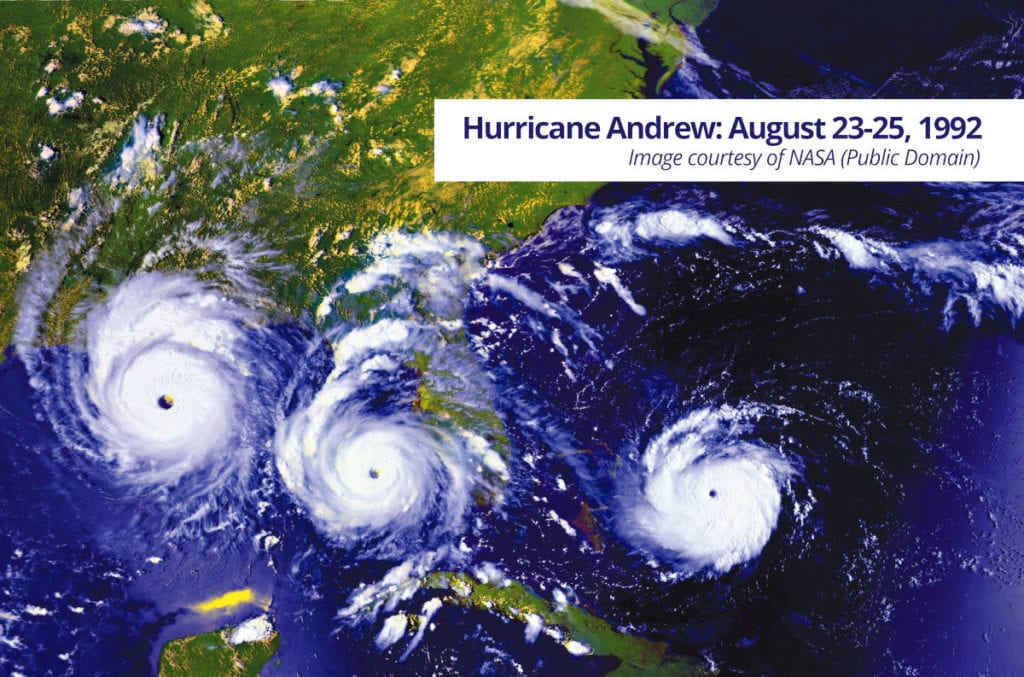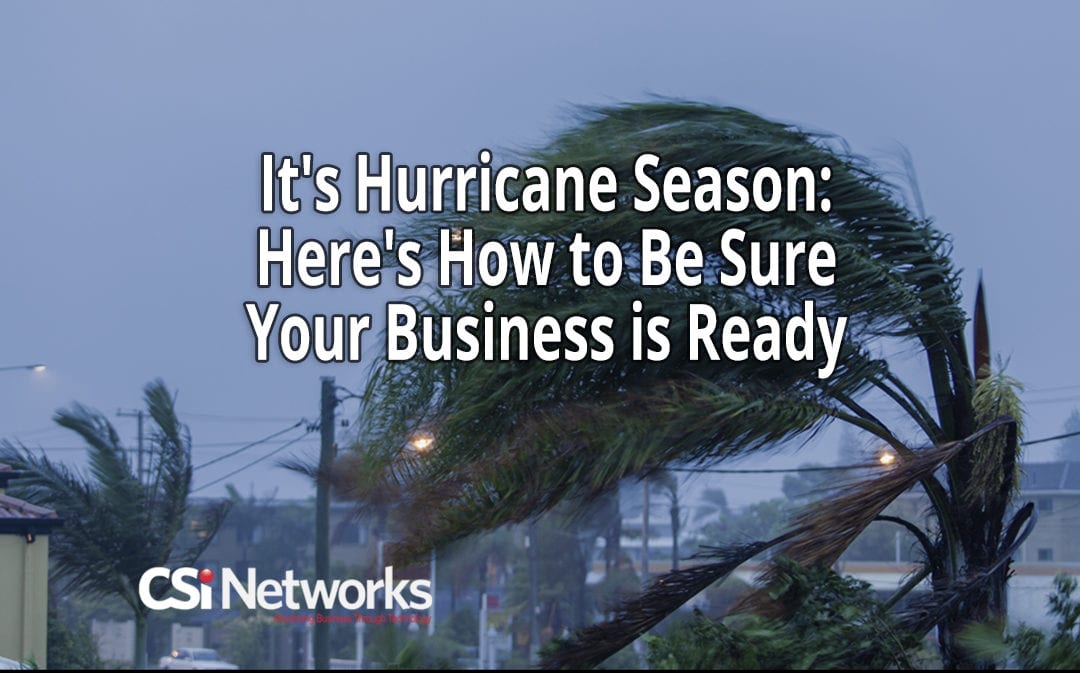
Unfortunately, it wasn’t the last major storm to hit Florida or the nation. 2004 saw Charley, Francis, Ivan & Jeanne rock the Gulf Coast. And of course, there were the storms called Katrina, Sandy, and Harvey.
This year, the experts are predicting a busier than usual hurricane season, with three to six of them expected to be severe — Category 3 or higher — hurricanes.
Is your business prepared?
Lessons Learned
One of the good things that came out of Andrew, and later the devastation of 2004, was a better electronic infrastructure. The internet as we know it now was just starting to emerge in 1992, but forward-thinking engineers pushed for more fiber-optics-based telecommunications. In the aftermath of Jeanne, phone companies started adding to their internet offerings. Suddenly there were options, including fiber, that freed us from our dependence on whatever cable company the state or city approved.
But — and it’s a big but — our businesses are now often completely dependent upon computers in order to function. Everything from critical data we generate and rely upon, to the files and databases maintained by water and power suppliers for our areas often requires technology to function as expected. Some of it’s onsite (in our offices, for example), some is “in the cloud”, and every day we rely more on our internet connections to do business.
Redundant Internet Connections
But what happens if your internet service provider (“ISP”) goes down?
Is business-class internet connectivity truly available all the time? When a storm knocks out lines, towers and connections, how much of a priority will it be for your ISP to restore service to your business?
How long can your business continue to function without an internet connection? An hour? A day? A week? Longer?
If your answer is that your business can’t survive long without an internet connection, then we highly recommend investing in a “failover” system. When your primary internet connection goes down, a failover system will automatically switch to a second (or third) internet connection — be it cable, fiber or even cellular.
For this to work seamlessly, you will need a business-class firewall at your location. This is the same type of device you need to properly set up employees to work from home or another remote location — something that might be required if a storm like Andrew or Katrina hit our area.
On a side note, if your current ISP isn’t one that sends a direct, hard line connection to your office, we’d recommend making it the backup and investing in a direct connection. Look for one that runs all or most of the cabling underground.
Alternative Power
No, we’re not talking about running your computers off of windmills. Although … think how cool that would be!
Even if we don’t get a direct hit, the high winds of even a tropical depression that comes close can cause widespread power outages, brown-outs and deadly-to-your-system power surges. Now is the time to make sure you have working, up-to-date battery backups that will keep your systems running or gracefully shut them down to prevent critical data loss.
Even a short term solution gives you a few minutes or an hour to make sure everything is saved and backed up. But the longer the battery backup can work, the more valuable it is to you. Double check to make sure the ones you bought a year (or five!) ago still provide the power they should and switch on automatically when they detect a fail.
You can also consider a generator, but those are less viable for some businesses, as you’d need to make sure there’s room for proper ventilation when operating it so you don’t make things worse for the building or your staff.
What’s the Plan, Boss?
Do you have a Disaster Recovery Plan? An inventory of all the hardware and software solutions you own and use? What’s your tolerance — physical and psychological — for downtime in your business? What resources do you have for employees working from home or just not coming in?
All of these questions should be answered by your Disaster Recovery Plan. You’ll also want a flowchart of who’s responsible for what (and their backup person) with contact info. And a clear, understandable communication plan. Like the one they used on the recent Parks & Rec reunion episode. Know how to get hold of everyone. And you’ll want to make sure they know how to access what they need to do their work.
Do you have an alternative worksite in case the building is flooded or half blown away? Do your service level agreements have disaster provisos with specific timeframe guarantees? What’s protecting your sensitive information, like customer data, personnel information and such, in the event of an emergency?
A written plan now can make a huge difference between getting back to business quickly or faltering when you make it up as you go.
Schedule a Free Disaster Recovery Consultation
Click here to set up a time for one of our experts to discuss your disaster recovery plan. We’ll cover all the items in this post plus any circumstances unique to your needs! There is no cost or obligation, although limitations apply.
Underwater Backups Are Not a Thing
While we highly recommend having a dedicated onsite backup server that you control, it’s not going to do you any good if it is waterlogged or ripped up by high winds.
In the event of a weather disaster, you will need offsite backups. This can be as simple as a server you backup everything — yes, everything — periodically (e.g. weekly), and certainly in the face of an impending storm. Or you can use a cloud-based solution. In that case, the backups can be more frequent — even immediate.
How frequently should your system back up your data? The answer to that depends upon how valuable the most recent changes are. Does information change quickly? Would data from a few hours/days/weeks ago be much less valuable? In some situations, data from a few days ago might be nearly worthless.
Another factor to keep in mind is the volume of data you’re backing up. Everything means everything, and the hours it takes to backup to your offsite through your wired connection could be days or even weeks. And don’t forget to calculate how long it will take to download and restore your data from the offsite location.
Speaking of restoring … how long has it been since you attempted to restore any data from your backup system? Testing the validity of your backed-up data is a critical step in ensuring that your process actually works.
Modern Phone Systems
What would happen if a customer tried to call your business after a storm had effectively shut your office down due to extended loss of power or perhaps something even more destructive? Sure … you can forward your phone line somewhere. But if your phone system is the traditional variety that involves something physically installed at your location, then a bunch of things stop working as expected:
- phone lines for inbound and outbound calling
- voicemails
- notifications
- intercom
- conference calling
With a modern hosted VoIP phone system, you and your employees can simply grab the phones from your desks and plug them into any internet connection — anywhere in the world! — and everything will continue to function exactly as if you were at your office.
What if you don’t take your phones home? Most VoIP systems allow for “soft phones” — mobile apps or software tools you can install on your computers — that function as if you were using the phone at your desk.
Here’s what’s even more exciting about hosted VoIP: many times it’s far less expensive than the traditional phone systems you might be using today. And there are a number of other time-saving, productivity-enhancing benefits as well. You can learn more about these and other ways to keep your operations running without your physical office/headquarters by watching this “Ask Us Anything: All About Remote Work” session we live-streamed not long ago with our team of geeks.
Relying on Experts
As you might imagine, you might consider implementing some of these solutions on your own. But others are more extensive and require expert help. Setting up a disaster plan, arranging for full-server imaging offsite, installing and configuring a business-class firewall, and evaluating a backup ISP that can serve your needs — these all work better when you have a partner.
Having a team of geeks who are familiar with your business, your server configuration, your hardware, software, and solutions allows for true disaster recovery and saves countless hours. Most small businesses — not to mention medical facilities and doctor’s offices — can’t afford losing a day, let alone weeks of shuttered business.
Hurricane season officially started June 1 (although we’re already 3 named storms in as of this writing). Are you prepared to recover from a catastrophic hit to your business? Now is the time to prepare.
When a hurricane is threatening, the insurance companies stop issuing homeowner’s policies. By the same token, you can’t wait until the storm tracker is predicting a path through your business to tackle hurricane preparedness. Call us today for help, or click here to schedule a free hurricane preparedness consultation.
